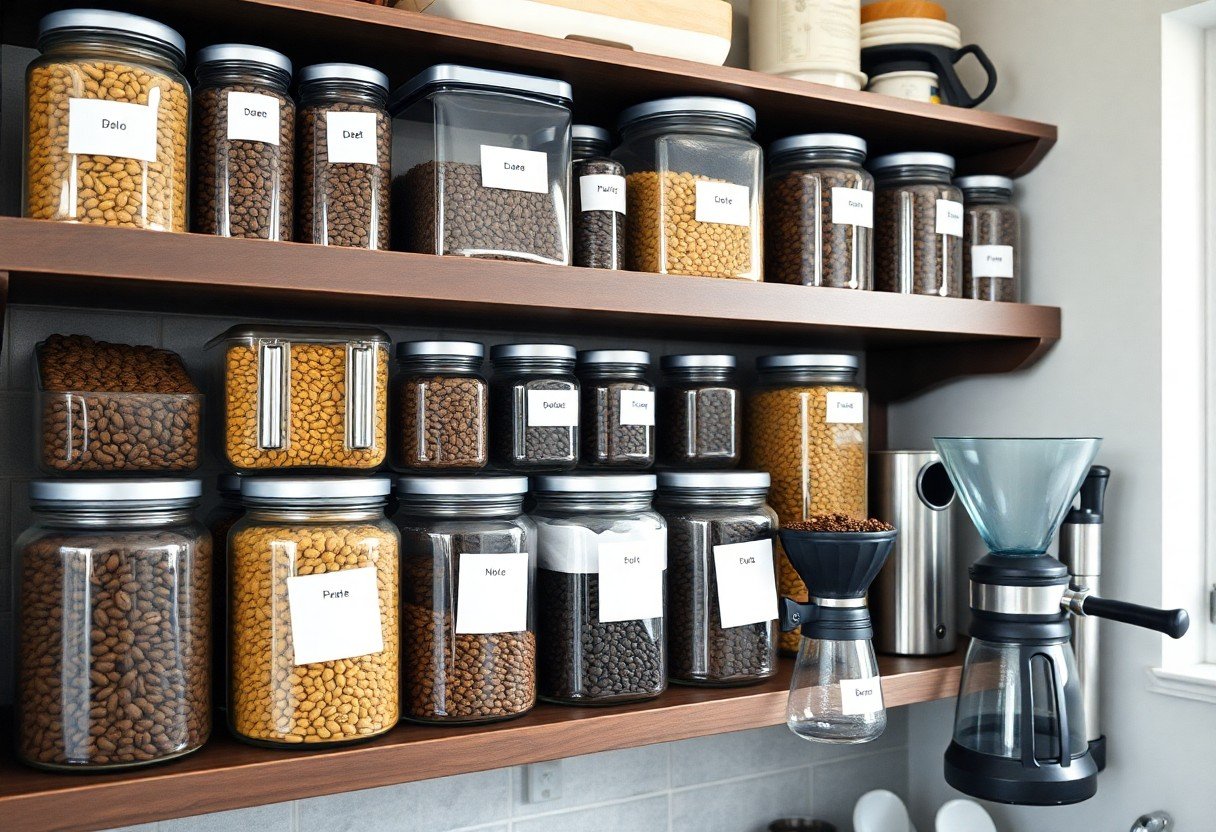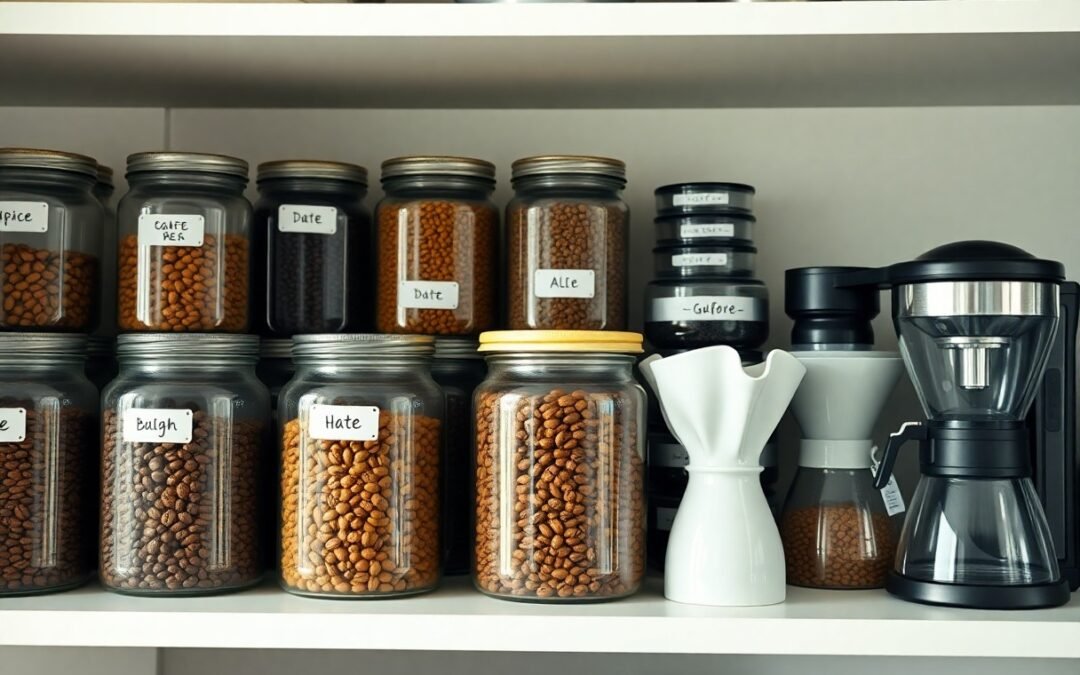There’s nothing quite like the rich aroma of freshly brewed coffee, but maintaining the optimal freshness of your coffee beans can be a challenge. In this ultimate guide, you’ll discover practical tips and expert advice to help you keep your coffee beans at their peak flavor for longer. By following these simple steps, you can enhance your coffee experience and ensure each cup is as delightful as the first. Get ready to elevate your brewing game!
The Chemistry of Coffee Bean Freshness
Understanding the chemistry behind coffee bean freshness gives you insight into preserving the delightful qualities of your brew. Fresh coffee beans contain a complex array of compounds, including oils, acids, and volatile organic compounds, which contribute to their rich flavor and aroma. Over time, exposure to air, light, and moisture leads to oxidation, which degrades these necessary compounds and diminishes the coffee’s freshness. You can take simple steps to minimize these effects and keep your beans as vibrant as possible.
Decoding the Degradation Process
As coffee beans age, they undergo a series of chemical transformations that impact their flavor profile. Oxidation is one of the primary culprits; it occurs when your beans are exposed to oxygen, causing their natural oils to become rancid. This process can start within hours after roasting, especially if they’re not stored properly. You’ll notice that stale coffee tastes flat, lacking the vibrant notes found in fresh beans. By understanding this decay, you can better protect the quality of your coffee supply.
How Freshness Affects Flavor and Aroma
The freshness of your coffee beans is fundamentally tied to the richness of your coffee’s flavor and aroma. Freshly roasted beans boast complex flavor profiles, including nuanced hints of sweetness, acidity, and distinct character from their origin. As beans lose their freshness, flavor compounds dissipate, leading to a generally flat and often bitter taste. This change can occur within two to three weeks of roasting, making proper storage necessary for retaining those delicious, aromatic qualities that elevate your coffee experience.

Essential Storage Solutions for Optimal Freshness
Choosing the right storage solution for your coffee beans is vital for maintaining their freshness and flavor. Factors such as light, air, temperature, and humidity all have a significant impact on how well your beans retain their quality. By employing effective storage methods, you can significantly prolong the life of your coffee, ensuring that each cup brewed is as delightful as the last.
Air-Tight vs. Vacuum Sealing: Which is Best?
In the matter of protecting your coffee beans from environmental factors, air-tight containers offer a reasonable solution by preventing oxygen exposure. However, vacuum-sealing truly takes the cake by eliminating most of the air content, thus slowing down the oxidation process more effectively. While both methods keep beans fresher longer, vacuum-sealing provides an extra layer of protection against flavor loss and stale aromas.
The Importance of Temperature and Humidity
Storing coffee beans at the ideal temperature and humidity levels is necessary for preserving their flavor profile. Optimal conditions hover around 60-70°F with humidity levels between 30-50%. Higher temperatures can accelerate the deterioration of the beans, leading to a loss in flavor and quality. Likewise, excessive humidity can cause beans to clump, encouraging mold growth and further compromising freshness.
| Temperature | 60-70°F (15-21°C) |
| Humidity | 30-50% |
Keeping your coffee beans in a temperature-controlled environment can make a significant difference in freshness. For instance, storing them in a cool, dark cupboard far away from heat sources like ovens or direct sunlight will help maintain their integrity. If you live in a particularly humid area, consider using a dehumidifier or a desiccant to mitigate moisture levels, thereby preserving the rich, complex flavors that make your coffee enjoyable.
| Light Exposure | Use opaque containers to block light |
| Oxygen Exposure | Avoid frequent opening of containers |
The Role of Beans’ Roast Profile in Freshness Longevity
The roast profile of coffee beans significantly influences their freshness longevity. Lighter roasts tend to preserve more of the beans’ natural oils and flavors, making them slightly more resilient against staleness. Conversely, darker roasts often lose these oils and can become flat more quickly due to the extensive heat exposure during roasting, which accelerates the degradation process. Understanding these differences allows you to choose beans that not only suit your flavor preferences but also align with your freshness goals.
Light vs. Dark Roasts: What You Need to Know
Light roasts generally maintain higher levels of acidity and brightness, featuring more complex flavor profiles, while dark roasts develop deeper, bolder flavors but risk losing some of these nuanced characteristics. When considering freshness, light roasts can last longer due to their retained oils, which helps to preserve their taste and aroma. Dark roasts, on the other hand, can flatter your palate but may sacrifice longevity for that robust flavor, making it crucial to consider your enjoyment versus the beans’ lifespan.
Understanding the Impact of Grind Size
The grind size of your coffee beans plays a pivotal role in how quickly they degrade after roasting. Finer grinds expose a larger surface area to air, which can facilitate rapid oxidation and loss of freshness. Coarser grinds, while ideal for some brewing methods, can retain flavor profiles longer due to the slower release of oils and gases. For example, if you opt for an espresso grind, be vigilant about using those beans promptly, as their freshness can diminish within days, compared to a coarser grind that remains flavorful for a longer period.
Advanced Preservation Techniques and Gadgets
Modern coffee preservation methods leverage advanced technology and innovative design to help you keep your beans fresher for longer. With the right gadgets and knowledge, you can ensure that every cup of coffee is as vibrant as the first. Here’s a breakdown of some options to consider.
| Technique/Gadget | Description |
|---|---|
| Vacuum Sealers | Eliminates air exposure by sealing coffee beans in an airtight bag, slowing oxidation. |
| CO2 Extraction Canisters | Removes carbon dioxide from freshly roasted beans, preventing rancidity. |
| Smart Coffee Canisters | These monitor humidity levels and automatically adjust to create optimal storage conditions. |
| Sealed Glass Jars | While basic, they offer good protection against UV light and air when used with silica gel packets. |
Innovations in Coffee Storage Technology
Recent advancements have revolutionized coffee bean storage. Smart storage solutions now include digital controls that alert you when humidity or environmental factors aren’t optimal. Alongside vacuum and CO2 extraction technology, these innovations offer you a precise approach to keeping coffee beans as fresh as possible. Maintain both flavor and fragrance, impressing even the most discerning coffee enthusiasts.
Everyday Items That Can Help Extend Freshness
Simple household items can also play a vital role in preserving the freshness of your coffee beans. Using materials like zip-lock bags or airtight containers you already own can provide an additional layer of protection. Besides that, some innovative methods like using rice can help absorb excess moisture, while dark-colored containers shield beans from light, ensuring they remain flavorful.
Incorporating everyday items into your coffee preservation routine is both budget-friendly and effective. For instance, an airtight glass jar from your pantry can become an excellent storage solution when combined with a few silica gel packets to absorb excess moisture. Alternatively, a quality zip-lock bag, when properly sealed, can minimize air exposure, keeping your precious beans vibrant. These small adjustments can make a significant difference in your coffee’s taste and aroma over time.
Best Practices for Coffee Usage and Consumption
Maximizing the flavor and aroma of your coffee involves not just storage but also careful consumption habits. Stick to a routine that puts the freshest beans to use, brewing only what you need to enjoy per session. This approach not only prevents waste but also ensures that each cup delivers the best possible experience. Using the right brewing equipment and techniques also plays a pivotal role in capturing the rich nuances of your chosen roast.
How to Properly Measure and Brew for Freshness
For optimal freshness, measure your coffee accurately, typically using a scale to achieve a 1:15 coffee-to-water ratio. Depending on your brewing method, this could be around 20 grams of coffee for every 300 milliliters of water. Be precise in the grind size—coarser for French press and finer for espresso—to enhance flavor extraction. Tailor the brewing time and temperature to your specific method, remaining aware that hotter water can extract more oils and flavors but may also introduce bitterness if over-extracted.
Recognizing Signs of Staleness and What to Do About It
Staleness in coffee manifests as flat, dull flavors, and an absence of aroma. Pay attention to changes in your coffee’s scent; a noticeable reduction often indicates a loss of freshness. If you find your brew lacks vibrancy or has a noticeably cardboard-like taste, that’s a sign it’s time to reassess your stash. Freshness varies by roast profile, so understand the typical lifespan of your preferred roast type to avoid disappointment during brew time.
Typically, coffee beans start losing their vibrant flavors within two to four weeks of roasting, depending on their roast profile. If you store beans in a non-airtight container, they may deteriorate even more quickly, leading to staleness characterized by a loss of depth in aroma and taste. Ignoring these signs can lead to disappointing brews. When you detect staleness, consider repurchasing fresher beans, and always prioritize airtight storage solutions alongside desiccant materials or CO2 valves to maintain the beans’ integrity for as long as possible.
Conclusion
Drawing together the best practices for extending the freshness of your coffee beans, you can significantly enhance your coffee experience. By properly storing your beans in airtight containers, keeping them away from light and moisture, and grinding them just before brewing, you can preserve the rich flavors and aromas. Additionally, purchasing smaller quantities and using them within a reasonable timeframe ensures that each cup you brew maintains its delightful quality. With these strategies, you’ll enjoy the full potential of your coffee every time.
FAQ
Q: How should I store my coffee beans to extend their freshness?
A: To extend the freshness of your coffee beans, it’s best to store them in an airtight container that blocks light and moisture. Glass jars with rubber seals, vacuum-sealed bags, or opaque containers made of metal or ceramic are excellent choices. Avoid storing your coffee beans in the fridge or freezer, as the temperature fluctuations and moisture can negatively impact the flavor. Instead, keep them in a cool, dry place away from direct sunlight.
Q: How can I tell if my coffee beans are still fresh?
A: To determine if your coffee beans are still fresh, pay attention to their aroma, appearance, and taste. Fresh coffee beans should have a strong, rich aroma. If they smell flat or stale, their freshness may be compromised. Visually, they should be oily and vibrant, not dull or chalky. When brewed, fresh beans should produce a well-rounded flavor with distinct notes. If you find the taste to be bitter or bland, it likely indicates that the beans have lost their freshness.
Q: Is it better to buy whole beans or pre-ground coffee for freshness?
A: Whole beans are generally a better choice for maintaining freshness compared to pre-ground coffee. When coffee beans are ground, they have a larger surface area that increases exposure to air, which can lead to faster oxidation and loss of flavor. Grinding your beans just before brewing preserves the important oils and flavors, resulting in a tastier cup of coffee. If possible, invest in a good-quality grinder to enjoy the freshest coffee experience.

